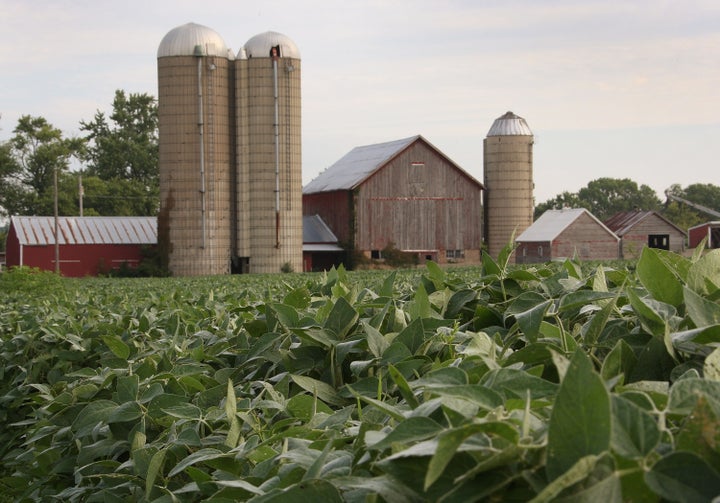
By Tom Philpott. This post originally appeared at grist.org.
In the ongoing debate about whether sustainable agriculture can "feed
the world," it's important not to lose sight of what industrial
agriculture is doing to ecosystems--both in specific areas and on a
grand scale.
Producing and distributing lots and lots of calories, leveraged by
fossil fuel and synthetic fertilizers and poisons, may solve certain
short-term problems; but the practice also creates long-term ones that
won't be easily solved.
In June, a study emerged showing that so-called inert ingredients in
Roundup, Monsanto's widely used flagship herbicide, can kill human
cells even at low levels--"particularly embryonic, placental and
umbilical cord cells," reports Scientific American.
This is an herbicide that's used on virtually all of our nation's corn
and soy fields, covering tens of millions of acres of cropland. (It's
also widely used by landscapers and on home lawns.)
Then there was the recent atrazine imbroglio. For years, the EPA has
been assuring the public that the highly toxic herbicide, still widely
used in the Corn Belt, wasn't showing up in drinking water in worrisome
levels. Turns out that was a lie, as some excellent muckraking by the Huffington Post Investigative Fund revealed. Atrazine exposure has been strongly associated with reproductive health maladies, including a rise in hermaphroditism among frog populations.
Note that corn and soy production, as practiced today, is completely reliant on these two broad-spectrum herbicides.
Now comes news about the hazards of another input critical to the
project of industrial agricultire: synthetic nitrogen fertilizer. When
farmers apply nitrogen to farm fields, a certain amount enters the
atmosphere as nitrous oxide. And according to a study conducted by
researchers at the National Oceanic and Atmospheric Administration
(NOAA) and published in Science, human-generated nitrous oxide is now
the No. 1 contributor to ozone-layer depletion.
The study is the first ever to look closely at nitrous oxide's role as an ozone destroyer. The results are alarming. From a summary of the study on the NOAA website:
For the first time, this study has evaluated nitrous oxide emissions
from human activities in terms of their potential impact on Earth's
ozone layer. As chlorofluorocarbons (CFCs), which have been phased out
by international agreement, ebb in the atmosphere, nitrous oxide will
remain a significant ozone-destroyer, the study found. Today, nitrous
oxide emissions from human activities are more than twice as high as
the next leading ozone-depleting gas.
The withering away of the ozone layer, which was slowed but not
stopped by the 1987 Montreal Protocol phasing out CFCs, is no trivial
matter. As the NOAA summary puts it:
The ozone layer serves to shield plants, animals and people from
excessive ultraviolet light from the sun. Thinning of the ozone layer
allows more ultraviolet light to reach the Earth's surface where it can
damage crops and aquatic life and harm human health.Moreover, the Montreal Protocol does not regulate nitrous oxide.
Of course, agriculture-induced nitrous oxide isn't just eating the
ozone layer. It's also a greenhouse gas with 300 times the
heat-trapping power of carbon dioxide.
Thus the implications of agriculture's reliance on synthetic
nitrogen fertilizer are literally earth-shaking: The way we're feeding
ourselves is contributing dramatically to two processes--climate change
and ozone depletion--that could literally make the planet uninhabitable
by humans.
Worse still, we my be seriously underestimating industrial
agriculture's nitrous oxide emissions. When considering agriculture's
contribution of nitrous oxide to the atmosphere, scientists have
assumed that about 1 percent of the nitrogen fertilizer applied by
farmers ends up in the atmosphere as nitrous oxide. The EPA operates
under that assumption, as did the Intergovernmental Panel on Climate
Change. But the real number may be considerably higher. A 2008 study
[PDF] by the Nobel-winning atmospheric chemist Paul Crutzen found that
as much as 5 percent of nitrogen fertilizer applied by farmers turns
into nitrous oxide--which would make agriculture a much larger
contributor to climate change (and ozone depletion) than is currently
assumed.
On top of all of that, nitrogen runoff from agriculture is also
strongly implicated in the creation of coastal dead zones--large algae
blooms that suck oxygen out of the sea and snuff out marine life.
What all of this points to is the need to bring ecological
considerations into agriculture. And in fact, there's already a budding
field known as agroecology.
Agrocecology is now at best a fringe field in academia; as public
funding for university research dries up, giant agribusiness firms like
Monsanto increasingly finance--and control--the research agenda. They have little interest in ecology and vested interests in pushing their own proprietary products.
Related Links: